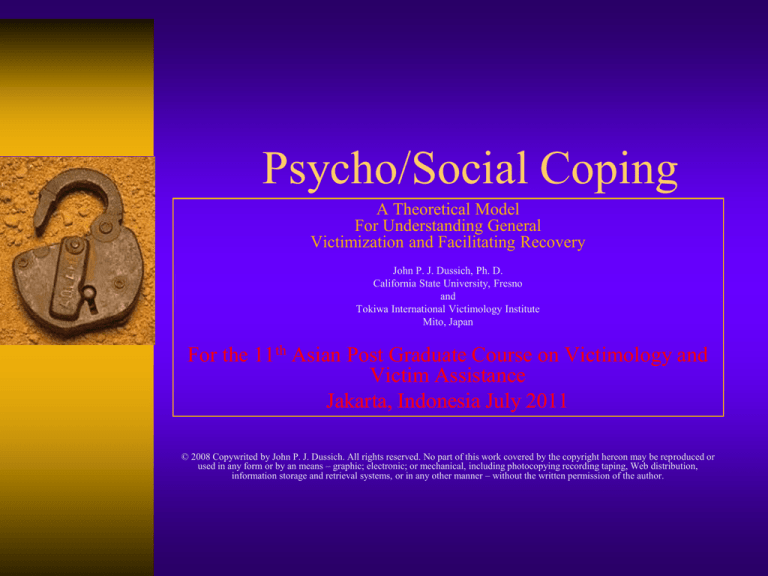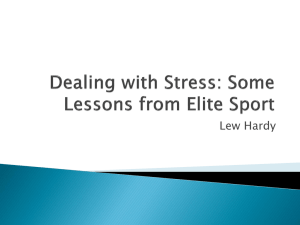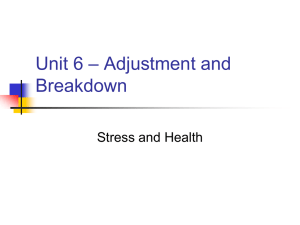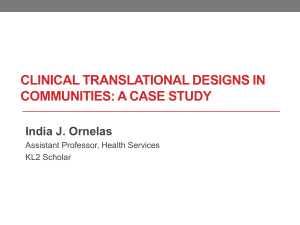
Psycho/Social Coping
A Theoretical Model
For Understanding General
Victimization and Facilitating Recovery
John P. J. Dussich, Ph. D.
California State University, Fresno
and
Tokiwa International Victimology Institute
Mito, Japan
For the 11th Asian Post Graduate Course on Victimology and
Victim Assistance
Jakarta, Indonesia July 2011
© 2008 Copywrited by John P. J. Dussich. All rights reserved. No part of this work covered by the copyright hereon may be reproduced or
used in any form or by an means – graphic; electronic; or mechanical, including photocopying recording taping, Web distribution,
information storage and retrieval systems, or in any other manner – without the written permission of the author.
Introductory comments
Coping is what persons do, physically, socially, and
cognitively to meet the demands of living. The objective
of coping is to reduce the stress brought about by the
presence of a problem.
Coping styles vary according to individuals, families, and
cultures. Some persons cope appropriately & others cope
inappropriately. Appropriate coping means being positive,
engaging in constructive problem solving, task-focused
behavior, working out, accepting help, etc.; while
inappropriate coping is blaming oneself or others, denying
the problem exists, trying to cope alone, use of drugs or
alcohol, being aggressive, etc. (Andrews, 1990).
Introductory comments cont.
Research has shown that persons who cope
appropriately (adaptively) have a better
sense of wellbeing, achieve better and are
generally more successful in life. Those
who cope inappropriately (maladaptively)
are not comfortable with themselves, are
lower achievers and have less success in
their lives (Frydenberg & Lewis, 1999,
2002). Coping is highly individualistic.
Theoretical Background
-The Psycho/Social Coping Model (P/SCM) is
offered as a general theory for understanding all
forms of victimization and for facilitating
recovery.
-This model uses behavioral versus legal concepts.
-Its primary goals are to be explanatory and
utilitarian.
-Its roots are derived from social psychology
phenomenology, social control theory, stress
theory, symbolic interactionism and
behaviorism.
THE PSYCHO/SOCIAL COPING
MODEL
ANTECEDENTS
COPING MILIEU
PERSONAL
RESOURCES
PROBLEM
APRAISAL
FEEDBACK
RESULTS
Success
COPING
PROCESS
Failure
The Coping Milieu
-The coping environment is called the Coping Milieu.
-The Coping Milieu is predominantly a physical,
social, and psychic interactive space within which a
person attempts to survive.
-The Coping Milieu is defined as that space in which a
person’s specific problem exists. For each person and
each problem the Coping Milieu is different.
-Within a Coping Milieu, each person has their own
personal resources available to confront problems in
the search for solutions.
The Psycho/Social Coping Model
The P/SCM starts with the Coping Milieu and an
individual’s 5 Personal Resources:
1.
2.
3.
4.
5.
Repertoire
Social assets
Psychic assets
Physical assets
Time
PERSONAL
RESOURCES
PSYCHIC
-intelligence
-personality
-education
-skills, etc.
COPING
REPERTOIRE
SOCIO
-social class
-sibling position
-roles
-friendship
-status, etc.
TIME
-PHYSIO
-age
-sex
-race
-health
-size, etc.
A Problem
-Within a given milieu and armed with personal resources, an
individual confronts a problem and makes an appraisal
(Lazarus, 1981).
-A problem is here defined as a multi-dimensional force
directed at a person that blocks status and/or the pursuit of
goals which creates physical, social and psychical stresses.
-Each problem is made up of numerous continua which, in
this model, are considered at a moment in time.
-The “problem moment” is a heuristic device that allows us to
freeze time so as to evaluate each different continuum.
- In response to a problem a person begins the coping process.
The Problem Moment Continua
1. Due Continuum - Time remaining for problem resolution.
2. Time Continuum - Length of time a problem has existed.
3. Person Continuum - Number of persons in the problem.
4. Severity Continuum – Complexity of the problem.
5. Threat Continuum - Extent of threat to a person’s wellbeing.
6. Evolution Continuum - Speed with which problem became
known.
7. Familiarity Continuum - Extent to which problem is known to
a person.
8. Context Continuum - Extent to which problem is in or out of
context.
Other continua are possible, such as: culture, social support, etc.
SAFE-5
PROBLEM MOMENT
CONTINUA TOOL
LATER-1
5- LIFE THREAT
1- SOONER
1. DUE CONTINUUM
2. TIME CONTINUUM
3. PERSON CONTINUUM
4. SEVERITY CONTINUUM
5. THREAT CONTINUUM
6. EVOLUTION CONTINUUM
7. FAMILIARITY CONTINUUM
8. CONTEXT CONTINUUM
- Time remaining for problem resolution.
- Length of time problem has existed.
- Number of persons involved in the problem.
- Complexity of the problem.
- Extent of threat to a person’s wellbeing.
- Speed with which problem become known.
- Extent to which problem is familiar to a person.
- Extent to which problem is in or out of context.
The Psycho/Social Coping Process
-This psycho/social coping process has four distinct phases:
1. Prevention (Starts with the awareness that a problem is possible.)
2. Preparation (Starts with the awareness that a problem is imminent.)
3. Action (Starts when the problem is present.)
4. Reappraisal (Starts after the problem is over.)
-Each phase is a continuum within which a person can make a
choice, with failure more likely at one end, and success
more likely at the other end.
prevention
THE FOUR PHASES OF
PSYCHO/SOCIAL COPING
+
REASONABLE ANTICIPATION OF A PROBLEM
-“proactive coping” (Aspinwall & Taylor, 1997)
-“anticipatory coping” (Schwartzer & Knoll, 2003)
preparation
+
(Kopp, 1982)
-
ABSENCE OF PREPARATION
- No Appraisal
- No Rehearsal
- No Worrying (Janis, 1965)
- No Practicing (Dussich, 1988)
PROBLEM-EVENT OCCURS
COPING
- Learned Resourcefulness
(Meichebaum, 1973)
- Self-Delivered Reassurance
- Diminished Vulnerability
-
DENYING THE LIKLIHOOD
OF A PROBLEM
AWARENESS AND APRAISAL OF A PROBLEM
PREPARATION
- Appraisal
- Rehearsal
- The Work of Worrying (Janis, 1965)
- The Work of Practicing (Dussich, 1988)
+
action
AWARENESS OF A PROBLEM POSSIBILITY
-
FAILURE TO COPE
- Learned Helplessness (Seligman, 1973)
- Disappointment in Protective
Authorities
- Increased Expectation of Vulnerability
reappraisal
(Meichenbaum, et al., 1975:339)
+
SECONDARY COPING
- Replay
- Assessment
PROBLEM-EVENT IS OVER
NO SECONDARY COPING
- No Replay
- No Assessment
-
Application to victimization and
recovery
-Victimization is an event whereby a person is
unable to cope with a personal attack due to
inadequate resources.
-Recovery is the end-state when a victim resumes a
functional life-style with significantly fewer
symptoms and adopts a positive identity of self.
-Inadequate resources result in vulnerability,
victimization, and a poor ability to recover.
-Adequate resources result in resiliency, safety, and
an enhanced ability to recover.
Victim Taxonomies based on the
Psycho/Social Coping Model
I. Pre-victimization conditions which increase vulnerability are:
1.
high-risk milieu
2.
distorted problem-appraisals
3.
psychic disabilities
4.
social disabilities
5.
physical disabilities
6.
limited time
7.
underdeveloped coping (inexperience)
8.
faulty coping (maladaptive)
Persons with these vulnerability conditions do not cope well and are at
high risk of being victimized in their personal milieu.
Victim Taxonomies based on the
Psycho/Social Coping Model continued
II. During-victimization conditions which facilitate adaptive coping
(Dussich, 1988; Mohino, et al., 2004):
1.
use of resourcefulness
2.
self-delivered reassurances
3.
positive thinking - learned optimism (Seligman, 1992)
4.
logical analysis
5.
rational action
6.
regulate negative emotions (Folkman & Moskowitz, 2004)
7.
positive reappraisal
8.
problem solving
9.
diminished vulnerability
Persons who use these techniques increase their chances of coping
adaptively.
Victim Taxonomies based on the
Psycho/Social Coping Model continued
III. General Post-victimization conditions related to
resources, appraisal, coping and recovery:
1. Victims with adequate personal resources, who
problem-appraise accurately, facilitate adaptive
coping and enhance their recovery.
2. Victims with inadequate personal resources, who
problem-appraise inaccurately, facilitate
maladaptive coping and continue their suffering.
Victim Taxonomies continued…
IV. Specific Post-victimization conditions which facilitate recovery:
1. healing milieu
2. positive intervention
3. psychic strengths
4. social strengths
5. physical strengths
6. time abundance
7. developed coping (mastery)
8. appropriate coping (adaptive)
9. approach coping (Griffith, et al. 2000)
Persons with these resiliency conditions cope well and have a high chance
of recovering from their victimization.
Main thesis of the Psycho/Social
Coping Model for victimization and
recovery.
Persons with few resources specific to their lifestyle have a higher likelihood of becoming
victims; if they become victims, they have a
poorer chance of surviving; and, if they survive,
they will not recover well and suffer more. On the
other hand, those with more resources specific to
their life-style have a higher chance to avoid
victimization, if victimized, will cope better,
recover sooner and suffer less.
Implications
-The P/SCM is herein used to understand the behaviors of
general victims (those who are harmed by any force)
(Mendelsohn, 1976; Dussich, 1988; Holley & Brewster,
2006).; and, is also used to assist in helping victims
recover (regardless how they were harmed).
-The P/SCM suggests that a “holistic multi-resource
approach” is essential to understand all forms of
victimization and recovery.
-Limited resources make persons vulnerable to victimization.
To prevent victimization, lacking resources must be
identified so that these vulnerable persons can be given
resources that are specific to their unique needs.
Implications cont.
-The P/SCM suggest that persons who have been victimized
must be empowered with tailored resources to prevent their
re-victimization or their conversion to offending.
-Notions of victim guilt or blame only have a place in legal
considerations, not for understanding victim behavior and
helping victims recover. Guilt or blame are usually
considerations when dealing with crime victims.
-Recovery is best facilitated by providing tailored resources
that are person-specific, culture-sensitive & situationrealistic.
-Appropriate coping can be taught and is a method that has
been shown to reduce violence in many settings, especially
schools (Lodge & Frydenberg, 2005).
-Some victims may need to learn new coping skills that were
never taught them at home. Of special importance are
problem solving skills: how to assess problems realistically,
search for alternative solutions based on their consequences,
selection of the best options, carrying out the selected option,
and, evaluating the results (Andrews, 1990).
Thank you for your attention!
References
Andrews, A. B. (1990). Crisis and Recovery Services for Family Violence Survivors. In A. Roberts (Ed.), (pp. 206-232)
Helping crime victims: Research, policy, and practice. Newbury Park, CA: Sage.
Aspinwall, L.G. & Taylor, S. E. (1997). A stitch in time: self-regulation and proactive coping. Psychology Bulletin. 121:
417-36.
Dussich, J. P. J. (1988) Social Coping: A Theoretical Model for Understanding Victimization and Recovery, in
Victimology: International Action and Study of Victims, Zvonimir Paul Šeparović (ed.), Zagreb: Somobar.
Folkman, S. & Moskowitz, J. T. (2004). Coping: Pitfalls and Promise. Annual Review of Psychology, 55:745-74.
Frydenberg, E. & Lewis, R. (1999). Academic and general well-being: The relationship with coping. Australian Journal of
Guidance and Counseling.9, 19-36.
Frydenberg, E. & Lewis, R. (2002). Adolescent well-being: Building young people’s resources. In E. Frydenberg (ed.)
Beyond coping: Meeting goals, visions and challenges. (Pp. 175-194). London: Oxford University Press.
Griffith, M. A., Dubow, E. F. & Ippolito, M. F. (2000). Developmental and Cross-Situational Differences in Adolescents’
Coping Strategies. Journal of Youth and Adolescence, Vol. 29, No. 2.
Holley, P. D. & Brewster, D. (2006) A 21st Century General Victimology: Combining General Victimology with Theory.
Presented at the 12th International Symposium on Victimology, World Society of Victimology, Orlando, Florida,
August 20-25.
Janis, I. (1965). Psychodynamic Aspects of Stress Tolerance. In S. Klausner (ed.). The Quest for Self-Control. New York:
Free Press.
Kopp, S. (1982). An End to Innocence. New York: Bantam.
Lazarus, R. S. (1981). The stress and coping paradigm. In C. Eisdorfer, D. Cohen, A. Kleinman & P. Maxim (Eds.), Models
for clinical psychopathology (pp. 177-214). New York: Spectrum.
References continued
Lodge, J. & Frydenberg, E. (2005). The Role of Peer Bystanders in School Bullying:
Positive Steps Toward Promoting Peaceful Schools. Theory into Practice, Fall, 44, (4).
Meichenbaum, D. H. (1973). Therapist Manual for Cognitive Behavior Modification,
Unpublished Manuscript, Waterloo, Ontario: University of Waterloo.
Meichenbaum, D. H., Turk, D. & Burstein, S. (1975). The Nature of Coping with Stress. In
I. G. Sarason, and C. D. Spielberger (eds.). Stress and Anxiety, Vol. 1, New York: John
Wiley and Sons.
Mendelsohn, B. (1976). Victimology and Contemporary Society’s Trends. Victimology,
Spring, 1,1, 8-28.
Mohino, S., Kirchner, T. & Forns, M. (2004). Coping Strategies in Young Male Prisoners.
Journal of Youth and Adolescence, Vol. 33, No. 1, February, pp. 41-49.
Seligman, M. P. (1973). Fall Into Helplessness. Psychology Today, 7.
Seligman, M. (1992). Learned optimism. New South Wales, Australia: Random House.
Schwarzer, R. & Knoll, N. (2003). Positive coping: mastering demands and searching for
meaning. In Comprehensive Handbook of Psychology, Vol. 9, ed. A. M. Anezu, C.M.
Nezu, P. A. Geller, New York: Wiley.










